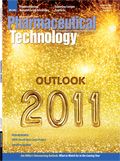The US Drug Supply Chain: Safety Must be Paramount
Holding product and supply-chain security to the highest standards is crucial for the future.
Extraordinary commitments by the pharmaceutical industry and the US Food and Drug Administration aim to ensure that prescription drugs sold in the US and throughout the supply chain are completely safe. Both FDA and industry continuously pursue every means available to help guarantee that the medicines patients and practitioners receive are of the highest quality.

Robert Billings
As FDA Commissioner Margaret Hamburg noted in February 2010 at the Center for Strategic and International Studies, all people of the world deserve access to safe food and quality medical care. She also noted that FDA is a critical player, domestically and internationally in promoting and protecting the health of the public.
With the contaminated heparin incident in 2008, it became apparent that those individuals intent on deliberately adulterating drug products were finding sophisticated means of operating. And while such incidents are rare, the realities of a globalized pharmaceutical marketplace have resulted in challenges and opportunities for industry and FDA to develop systems to protect the quality of the materials used in drug manufacturing and the security of products as they move from the original source to the end user. Approximately 4 billion prescriptions were dispensed in the US in 2009, according to IMS Health. That number equates to several billions of tablets, capsules, liquids, injectables, inhalation units, and other dosage forms, and the active ingredients used in making them, moving through the supply chain. However, the Generic Pharmaceutical Association (GPhA) believes that careful vigilance by FDA, manufacturers, and supply-chain stakeholders can keep the prevalence of drug contamination and intentional adulteration low.
Combatting counterfeits
Proactive efforts to protect consumers from counterfeit drugs also must be a priority. Although most drugs, including the generic drugs that account for 75% of all prescriptions dispensed in the US, are seldom targeted by counterfeiters, counterfeit versions of some of the most expensive prescription medicines continue to appear in the marketplace. Many of these counterfeit versions are sold over the Internet with little or no regulatory control. Counterfeit drugs present a significant risk to public health, not only because they are unapproved, but also because they fail to deliver the needed therapeutic effect to the user.
Keeping counterfeit and contaminated drugs out of the US supply requires a dual effort spearheaded by FDA and industry. Only through corporative and coordinated action can the necessary oversight and controls be capable of maintaining drug security. For instance, the new border-control initiative developed by FDA is an excellent endeavor to curtail the incidence of poor standard medicines entering the US from other countries. This program, Predictive Risk-based Evaluation for Dynamic Import Compliance Targeting (PREDICT), encompasses a border-based method that assesses drugs at the point of import. Barcodes on cases of medicines will be scanned at US points of entry and linked to a central database.
As a result, FDA border agents will know immediately whether the producer has a license to ship and sell drugs into the US. If the products do not meet FDA compliance, they will not be allowed passed the borders. For its part, the pharmaceutical industry uses multiple strategies to prevent counterfeit drugs from entering the US supply chain, including comprehensive vender audits, robust controls of the supply chain, monitoring and control of qualified shipping channels to name a few.
Supply-chain and testing controls
Regarding the supply and distribution, manufacturers must continue their robust testing and supplier oversight to ensure that quality is built into the process. Innovator-drug firms operate in a highly regulated environment, and rightly so. Makers of finished dosage forms methodically and meticulously evaluate the plants, manufacturing practices, and quality control capabilities of their suppliers' inactive and active ingredients suppliers.
These company-led assessments provide the foundation for drug-product quality by ensuring that prudent and deliberate steps are taken to eliminate potential contamination or adulteration in distribution channels. Moreover, manufacturers test incoming raw materials for quality, purity, and potency in accordance with FDA-approved analytical methods. The test methods in place are designed to ensure that all active ingredients and other raw materials meet their predetermined quality attributes. Finished-dosage manufacturers also perform sophisticated testing during the manufacturing process that helps to verify that prescription medicines delivered to consumers and patients meet all standards for quality, purity, and potency.
Additional monitoring
As drug products are shipped to wholesalers, pharmacies or other intermediaries, the pharmaceutical industry uses multiple controls to mitigate the risk of contamination or adulteration. Careful planning of drug shipments, along with strict supply-chain custody and controls, are part of the logistical operations that provide accountability and oversight of products moving through the supply channels. These judicious controls enable manufacturers to determine any deviation from the predetermined agenda for shipment and custody.
Overlaying these industry efforts is an extra level of protection provided by the FDA through its oversight of raw materials and finished dose suppliers. Although unfortunate events undoubtedly will occur from time to time, FDA's high standards for API and prescription drug production are the most rigorous in the world.
The pharmaceutical industry, including GPhA members, strongly supports FDA's vision of a safe and secure prescription drug supply chain based on transparency and accountability by all persons who handle prescription medicines throughout the supply chain. As the industry continues to expand its global footprint, no shortcuts in drug-product quality or supply-chain security can be allowed. FDA and industry must remain unyielding in their commitment to the delivery of safe and effective medicines to all Americans.
Overall, GPhA is committed to supporting ongoing FDA supply-chain security initiatives as well as voluntary industry efforts such as Rx–360 and other programs to ensure that all products are safe and effective for the consumer.
Bob Billings is vice-president for policy and interim executive director of the Generic Pharmaceutical Association (GPhA).
